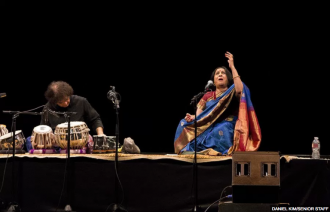“Ojai at Berkeley,” in partnership with Cal Performances, is an extension of Southern California’s annual Ojai Music Festival. The concert series ran Thursday through Saturday, hosting a broad selection of talented musicians trained in a wide variety of musical acumens. The program is musically directed by Vijay Iyer, a UC Berkeley alumnus and accomplished pianist and composer.
There were four events in total as part of the festival, each one offering a unique musical reinvention of genre — samplings of Iyer’s original work, pairings with fellow esteemed composers and musicians and collaborations across mediums were all included under the umbrella of “Ojai at Berkeley.” On Friday night in Zellerbach Playhouse, attendees were treated to “Afterword, an opera,” a new piece from innovative composer George Lewis. The following afternoon, Iyer himself took the stage in Zellerbach Hall for “Vijay Iyer and Friends: Confluence,” in which he performed with a group of other musicians in an exploration of the intersection between Carnatic music and jazz.
George Lewis’ “Afterword, an opera”
Composer George Lewis’ “Afterword, an opera” is based on the afterword of Lewis’ book, “A Power Stronger Than Itself: The AACM and American Experimental Music,” which traces the founding and history of the Association for the Advancement of Creative Musicians, or AACM. The AACM is a well-known organization that seeks to promote the production of original, avant-garde music created by Black musicians — including improvisatory jazz and experimental classical music. The story is told by three singers — soprano Joelle Lamarre, contralto Gwendolyn Brown and tenor Julian Terrell Otis — and the work is not only musically unconventional, but politically relevant.
George Lewis’ compositions are, in a word, formidable — deliberately discordant and cacophonous, a creaking jumble of piercing flute and distressed violin that is deceptively precise.
Melodically, Lewis is more than demanding of his vocalists; of his soprano, he requires a perfect balance between power and restraint, of his contralto, a broad range and authoritative energy, and of his tenor, a fiery restlessness coupled with a brave tenderness. His cast meets their respective challenges capably, and when the three singers come together — united in a single, booming vibrato — the sheer force of their sound could collapse a mountain.
Unfortunately, “Afterword, an opera” struggled to find its proper pace, despite the vocalists’ strengths. Though the piece picks up significant momentum throughout the beginning of the second act, by the end, it forces its message upon the audience in a tell, not show, fashion — the final lyrics explicitly outline the story’s takeaways: “Stop trying to be like others / Follow the thought of who you are / We’re still a part of the power that’s stronger than itself / Forever.” Compared to the nuanced, emotionally charged narratives of the opera’s opening, this finale came across as sermonizing, and by extension, far less engaging.
The choice to tell the story of experimental African-American music as an opera was certainly not arbitrary — the juxtaposition of a such a traditional, classical style and a narrative exploring the groundbreaking achievements of musicians of color was brilliantly executed — the disparity never quite acknowledged, but nevertheless powerfully present. Opera is well known for both its musical stringency and its racial and economic exclusivity, but Lewis is able to subvert these traditions with his unusual orchestrations and progressive subject matter.
The three characters sing again and again that they long to empower themselves and honor their ancestors with original compositions, yet they are confined to expressing these desires in traditional operatic style, reflecting the restriction from self-expression and cultural celebration that they must overcome within the narrative. It’s a politically potent artistic choice, one that Lewis leverages to his advantage; in the act of challenging opera’s limitations, “Afterword, an opera” becomes as inventive and revolutionary as the AACM itself.
“Vijay Iyer and Friends: Confluence”
“Vijay Iyer and Friends: Confluence” took place in Zellerbach Hall on Saturday afternoon and featured Vijay Iyer on piano with Zakir Hussain on the tabla, Rudresh Mahanthappa on the saxophone and Aruna Sairam as vocalist. The concert was a celebration of the intersections between jazz and South Indian Carnatic styles, and its four musicians came together not just as masters of their respective instruments, but as close friends.
The true champion of the concert was the legendary Hussain on the tabla — a pair of hand drums that change pitch with varying pressure. His hands, two hives of swarming fingers, moved at such blazing speed that you wondered how he kept them from smoking.
Rudresh Mahanthappa’s original composition, titled “Eeeeee” — “which means it’s in G, of course,” joked Iyer —was a masterful work, one that allowed each musician equal time to demonstrate their remarkable skills. In other pieces, Mahanthappa’s saxophone sometimes felt neglected in favor of Sairam’s vocals, which in turn relied too heavily on texturing rather than delivering a melody.
The call-and-response may be characteristic of jazz music, but the four musicians took the concept and transformed it. Picture something of a musical conversation, and then accelerate it to 20 times the speed, and you can begin to understand the rapid coordination with which Iyer, Mahanthappa, Sairam and Hussain passed the melody back and forth to each other.
This coordination would have likely been impossible had it not been for the palpable chemistry between the musicians. There is magic in sharing the stage with friends, not just in a demonstration of skill but in a celebration of mutual admiration. If anything, the playfulness, humor and sheer joy expressed by the group is what eventually earned them their encore, and what made “Ojai at Berkeley” such a unique, dynamic pleasure.
Shannon O’Hara is the assistant arts & entertainment editor. Contact her at sohara@dailycal.org.
